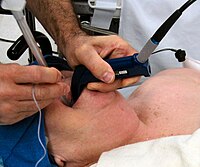
Photo from wikipedia
Background For patients with novel coronavirus 2019 (COVID-19) who undergo emergency endotracheal intubation, there is limited data regarding the practice, outcomes and complications of this procedure. Research Question For COVID-19… Click to show full abstract
Background For patients with novel coronavirus 2019 (COVID-19) who undergo emergency endotracheal intubation, there is limited data regarding the practice, outcomes and complications of this procedure. Research Question For COVID-19 patients requiring emergency endotracheal intubation, how do the procedural techniques, the incidence of first pass success and the complications associated with the procedure compare with intubations on critically ill patients prior to the COVID-19 pandemic? Study Design and Methods We conducted a retrospective study of adult COVID-19 patients at Montefiore Medical Center who underwent first-time endotracheal intubation by critical care physicians between July 19, 2019 and May 1, 2020. The first COVID-19 patient was admitted to our institution on March 11, 2020, before which patients were designated as the pre-pandemic cohort. Descriptive statistics was used to compare groups. A Fischer’s exact test was used to compare categorical variables. A two-tailed Student’s t-test for parametric variables or a Wilcoxon rank sum test for nonparametric variables were utilized for continuous variables. Results 1,260 intubations met inclusion criteria (782 pre-pandemic, 478 pandemic). Patients during the pandemic were more likely to be intubated for hypoxemic respiratory failure (72.6% vs 28.1%; P<0.01). During the pandemic, operators were more likely to use video laryngoscopy (89.4% vs 53.3%, P<0.01) and neuromuscular blocking agents (86.0% vs 46.2%; P<0.01). First pass success was higher during the pandemic period (94.6% vs 82.9%; P<0.01). The rate of associated complications was higher during the pandemic (29.5% vs 15.2%; P<0.01), a finding driven by a higher rate of associated hypoxemia during or immediately after the procedure (25.7% vs 8.2%; P<0.01). Interpretation We have shown that video laryngoscopy and neuromuscular blockade were increasingly utilized during the COVID-19 pandemic. Despite a higher rate of first pass success during the pandemic, the incidence of complications associated with the procedure was higher.
Journal Title: Chest
Year Published: 2021
Link to full text (if available)
Share on Social Media: Sign Up to like & get
recommendations!